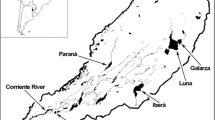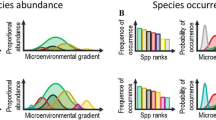Abstract
Macrophyte complexity has been associated with high abundance and richness of macroinvertebrates. While the effect on richness has been attributed to an increase in the number of niches, the effect on abundance has been explained by a higher availability of space for small individuals, refuge, and/or food. For studying effects of complexity on macroinvertebrates, we used complementary approaches of laboratory choice and field colonization experiments, with macrophytes (Egeria densa and Elodea ernstae) and plastic imitations of contrasting fractal dimension. We investigated whether macroinvertebrates may actively select complex habitats by Hyalella sp. choice experiments. Then, we tested effects of complexity on macroinvertebrate density, biomass, richness, diversity, and body size using colonization experiments. Finally, a caging experiment was performed to study interacting effects of complexity and predation. The active choice of complex substrates by Hyalella sp., and the significant positive relationship between macrophyte fractal dimension and macroinvertebrate density support the existence of a positive effect of complexity on abundance. As macroinvertebrate length was not associated with fractal dimension, such differences could not be attributed to a higher space available for smaller invertebrates in complex plants. Finally, neither macroinvertebrate density nor size was reduced by fish predation in the Las Flores stream.








Similar content being viewed by others
References
APHA, 1995. Standard Methods for the Examination of Water and Wastewater. American Public Health Association Inc., Washington, DC.
Armstrong, D. P. & T. D. Nudds, 1985. Factors influencing invertebrate size distributions in prairie potholes and implications for coexisting duck species. Freshwater Invertebrate Biology 4: 41–47.
Bartholomew, A. & K. Ebeid, 2011. Habitat complexity influences the microhabitat choices of desert beetles. Israel Journal of Ecology and Evolution 57: 213–221.
Bartholomew, A. & R. L. Shine, 2008. Space size relative to prey width (Sp/Py) influences macrofaunal colonization of artificial structures. Marine Ecology Progress Series 358: 95–102.
Bartholomew, A., R. J. Diaz & G. Cicchetti, 2000. New dimensionless indices of structural habitat complexity: predicted and actual effects on a predator’s foraging success. Marine Ecology Progress Series 206: 45–58.
Beukers, J. S. & G. P. Jones, 1998. Habitat complexity modifies the impact of piscivores on a coral reef fish population. Oecologia 114: 50–59.
Cattaneo, A. & J. Kalff, 1980. The relative contribution of aquatic macrophytes and their epiphytes to the production of macrophytes beds. Limnology & Oceanography 25: 280–289.
Cheruvelil, K. S., P. A. Soranno & R. D. Serbin, 2000. Macroinvertebrates associated with submerged macrophytes: sample size and power to detect effects. Hydrobiologia 441: 133–139.
Clench, H., 1979. How to make regional lists of butterflies: some thoughts. Journal Lepidopterist’s Society 33: 216–321.
Colwell, R. K., 2006. EstimateS: Statistical estimation of species richness and shared species from samples, Version 8. Persistent. purl.oclc.org/estimates.
Cooper, S., L. Barmuta, O. Sarnelle, K. Kratz & S. Diehl, 1997. Quantifying spatial heterogeneity in streams. Journal of the North American Benthological Society 16: 174–188.
Coull, B. C. & J. B. J. Wells, 1983. Refuges from fish predation: experiments with phytal meiofauna from the New Zealand rocky intertidal. Ecology 64: 1599–1609.
Crowder, L. B. & W. E. Cooper, 1982. Habitat structural complexity and the interaction between bluegills and their prey. Ecology 63: 1802–1813.
Dibble, E. D., K. J. Killgore & G. O. Dick, 1996. Measurement of plant architecture in seven aquatic plants. Journal of Freshwater Ecology 11: 311–318.
Diehl, S., 1992. Fish predation and benthic community structure-the role of omnivory and habitat complexity. Ecology 73: 1646–1661.
Dionne, M. & C. L. Folt, 1991. An experimental analysis of macrophyte growth forms as fish foraging habitat. Canadian Journal of Fisheries and Aquatic Sciences 48: 123–131.
Dodds, W. K. & B. J. F. Biggs, 2002. Water velocity attenuation by stream periphyton and macrophytes in relation to growth form and architecture. Journal of the North American Benthological Society 21: 2–15.
Feijoó, C. & R. Lombardo, 2007. Baseline water quality and macrophytes assemblages in Pampean streams: a regional approach. Water Research 41: 1399–1410.
Ferreiro, N., C. Feijoó & L. Leggieri. 2010. Efecto de la complejidad de las macrófitas sobre la densidad de los macroinvertebrados acompañantes en un arroyo pampeano. Libro de resúmenes de la IV Reunión Binacional de Ecología. Asociación Argentina de Ecología (ASAE) – Sociedad de Ecología de Chile (SOCECOL). http://www.conicet.gov.ar/new_scp/detalle.php?keywords=&id=23411&congresos=yes&detalles=yes&congr_id=906863.
Ferreiro, N., C. Feijoó, A. Giorgi & L. Leggieri, 2011. Effects of macrophyte heterogeneity and food availability on structural parameters of the macroinvertebrate community in a Pampean stream. Hydrobiologia 664: 199–211.
Ferreiro, N., A. Giorgi & C. Feijoó, 2013. Effects of macrophyte architecture and leaf shape complexity on structural parameters of the epiphytic algal community in a Pampean stream. Aquatic Ecology 47: 389–401.
Gaston, K. J. & J. H. Lawton, 1988. Patterns in the distribution and abundance of insect populations. Nature 331: 709–712.
Giorgi, A., C. Feijoó & G. Tell, 2005. Primary producers in a Pampean stream: temporal variation and structuring role. Biodiversity and Conservation 14: 1699–1718.
Gosselain, V., C. Hudon, A. Cattaneo, P. Gagnon, D. Planas & D. Rochefort, 2005. Physical variables driving epiphytic algal biomass in a dense macrophyte bed of the St. Lawrence River (Quebec, Canada). Hydrobiologia 534: 11–22.
Gotelli, N. J. & R. K. Colwell, 2001. Quantifying biodiversity: procedures and pitfalls in the measurement and comparison of species richness. Ecology Letters 4: 379–391.
Gregg, W. W. & F. L. Rose, 1982. The effects of aquatic macrophytes on the stream microenvironment. Aquatic Botany 14: 309–324.
Gunnarsson, B., 1992. Fractal dimension of plants and body size distribution in spiders. Functional Ecology 6: 636–641.
Halley, J., S. Hartley, A. Kallimanis, W. Kunin, J. Lennon & S. Sgardelis, 2004. Uses and abuses of fractal methodology in ecology. Ecology Letters 7: 254–271.
Hansen, J. P., S. A. Wikström, H. Axemar & L. Kautsky, 2011. Distribution differences and active habitat choices of invertebrates between macrophytes of different morphological complexity. Aquatic Ecology 45: 11–22.
Hauser, A., M. Attrill & P. Cotton, 2006. Effects of habitat complexity on the diversity and abundance of macrofauna colonizing artificial kelp holdfasts. Marine Ecology Progress Series 325: 93–100.
Heck, K. & L. Crowder, 1991. Habitat structure and predator prey interactions in vegetated aquatic systems. In Bell, S., E. McCoy & H. Mushinsky (eds), Habitat Structure: The Physical Arrangement of the Objects in Space. Chapman and Hall, London: 281–299.
Kelaher, B. P., 2003. Changes in habitat complexity negatively affect diverse gastropod assemblages in coralline algal turf. Oecologia 135: 431–441.
Kimball, S. & P. Mattis, 1996–2008. GNU Image Manipulation Program (GIMP). http://www.gimp.org.
Krebs, C. J., 1986. Capítulo 4: 19–20. In Krebs, C. J. (ed.), Ecología: análisis experimental de la distribución y abundancia, 2ª ed. Pirámide, Madrid.
Krecker, F. H., 1939. A comparative study of the animal populations of certain submerged plants. Ecology 20: 553–562.
Lillie, R. A. & J. Budd, 1992. Habitat architecture of Myriophyllum spicatum L. as an index to habitat quality for fish and macroinvertebrates. Journal of Freshwater Ecology 7: 113–125.
Lucena-Moya, P. & I. C. Duggan, 2011. Macrophyte architecture affects the abundance and diversity of littoral microfauna. Aquatic Ecology 45: 279–287.
MacAbendroth, L., P. Ramsay, A. Foggo, S. Rundle & D. Bilton, 2005. Does macrophyte fractal complexity drive invertebrate diversity, biomass and body size distributions? Oikos 111: 279–290.
MacArthur, R. H. & J. W. MacArthur, 1961. On bird species diversity. Ecology 42: 594–598.
Mittelbach, G. G., 1981. Patterns of invertebrate size and abundance in aquatic habitats. Canadian Journal of Fisheries and Aquatic Sciences 38: 896–904.
Morse, D., J. Lawton, M. Dodson & M. Williamson, 1985. Fractal dimension of vegetation and the distribution of arthropod body length. Nature 314: 731–733.
Rasband, W., 1997–2008. ImageJ. U.S. National Institutes of Health, Bethesda, MD. http://rsb.info.nih.gov/ij/.
Russo, A. R., 1987. Role of habitat complexity in mediating predation by the gray damselfish Abudefduf sordidus on epiphytal amphipods. Marine Ecology Progress Series 36: 101–105.
Schmid, P. E., 2000. Fractal properties of habitat and patch structure in benthic ecosystems. Advances in Ecological Research 30: 339–401.
Schmid, P. E., M. Tokeshi & J. M. Schmid-Araya, 2000. Relation between population density and body size in stream communities. Science 289: 1557–1560.
St. Pierre, J.I., & K.E. Kovalenko, 2014. Effect of habitat complexity attributes on species richness. Ecosphere 5: 1–10.
Stead, T. K., J. M. Schmid-Araya, P. E. Schmid & A. G. Hildrew, 2005. The distribution of body size in a stream community: one system, many patterns. Journal of Animal Ecology 74: 475–487.
Stewart, T., T. Shumaker & T. Radzio, 2003. Linear and nonlinear effects of habitat structure on composition and abundance in the macroinvertebrate community of a large river. American Midland Naturalist 149: 293–305.
Sugihara, G. & R. May, 1990. Application of fractals in ecology. Trends in Ecology & Evolution 5: 79–86.
Taniguchi, H., S. Nakato & M. Tokeshi, 2003. Influences of habitat complexity on the diversity and abundance of epiphytic invertebrates on plants. Freshwater Biology 48: 718–728.
Thomaz, S., E. Dibble, L. Evangelista, J. Higuti & L. Bini, 2008. Influence of aquatic macrophyte habitat complexity on invertebrate abundance and richness in tropical lagoons. Freshwater Biology 53: 358–367.
Tokeshi, M. & S. Arakaki, 2012. Habitat complexity in aquatic systems: fractals and beyond. Hydrobiologia 685: 27–47.
Tolonen, K. T., H. Hämäläinen, I. J. Holopainen, K. Mikkonen & J. Karjalainen, 2003. Body size and substrate association of littoral insects in relation to vegetation structure. Hydrobiologia 499: 179–190.
Warfe, D. M. & L. A. Barmuta, 2004. Habitat structural complexity mediates the foraging success of multiple predator species. Oecologia 141: 171–178.
Warfe, D. M. & L. A. Barmuta, 2006. Habitat structural complexity mediates food web dynamics in a freshwater macrophyte community. Oecologia 150: 141–154.
Warfe, D. M., L. A. Barmuta & S. Wotherspoon, 2008. Quantifying habitat structure: surface convolution and living space for species in complex environments. Oikos 117: 1764–1773.
Williamson, M. & J. Lawton, 1991. Fractal geometry of ecological habitats. In Bell, S., E. McCoy & H. Mushinsky (eds), Habitat Structure: The Physical Arrangement of the Objects in Space. Chapman and Hall, London: 69–86.
Wilzbach, M. A., K. W. Cummins & R. A. Knapp, 1988. Toward a functional classification of stream invertebrate drift. Verh Internat Verein Limnol 23: 1244–1254.
Acknowledgments
The authors are grateful to the landowner and the manager of Santa María del Arroyo farm for providing access to the study site. We thank the editor and two anonymous reviewers for their careful reading and constructive comments, who greatly improved this manuscript. This project was supported by the Universidad Nacional de Luján.
Author information
Authors and Affiliations
Corresponding author
Additional information
Handling editor: Katya E. Kovalenko
Electronic supplementary material
Below is the link to the electronic supplementary material.
Online Resource 1
Photographs of Elodea, a) control and b) treated to simplify architecture. (TIFF 994 kb)
Online Resource 2
ANOVA results for macroinvertebrate density (N g−1) in all the experiments. (DOC 35 kb)
Online Resource 3
Relationship between log N and log L of macroinvertebrates from each species and predation level. (EPS 2083 kb)
Rights and permissions
About this article
Cite this article
Ferreiro, N., Feijoó, C., Giorgi, A. et al. Macroinvertebrates select complex macrophytes independently of their body size and fish predation risk in a Pampean stream. Hydrobiologia 740, 191–205 (2014). https://doi.org/10.1007/s10750-014-1953-y
Received:
Revised:
Accepted:
Published:
Issue Date:
DOI: https://doi.org/10.1007/s10750-014-1953-y




